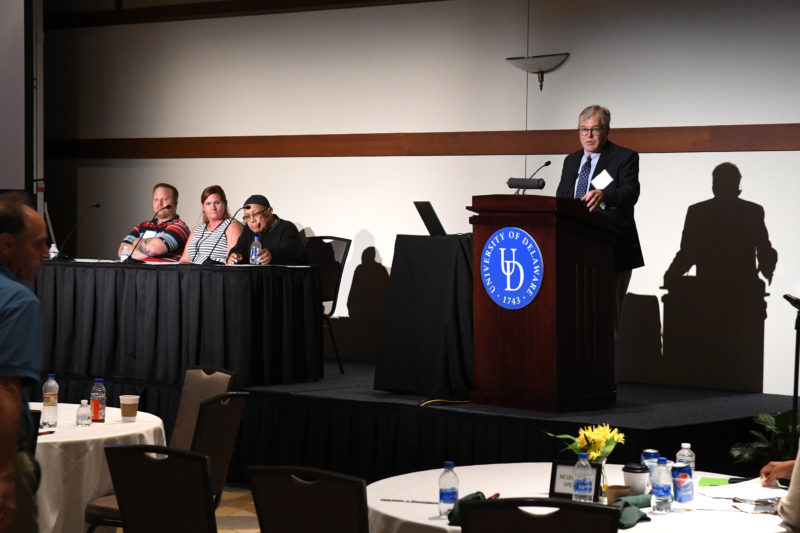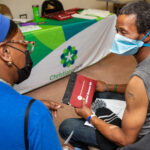Albert White was 13 when he started using opioids. By the time he was 72, he’d been married three times.
“I loved the drugs more,” he said.
He was ill, and his house was in foreclosure. Suicide seemed to him like the only solution.
A social worker took White to Christiana Hospital, where he met Terry Horton, M.D., medical chief of Addiction Medicine at Christiana Care. White now takes Suboxone to help combat opioid addiction. He hasn’t used opioids for two years.

White was a panelist at the Sixth Annual Addiction Medicine Symposium, Sept. 25 in John M. Clayton Hall at the University of Delaware. More than 170 physicians, nurses, social workers and counselors attended the event, which was sponsored by Christiana Care Health System and Central East ATTC, a program of the Danya Institute, which offers training, leadership and organizational development to behavioral health care providers and consumers.
Janice E. Nevin, M.D., MPH, president and CEO of Christiana Care, in her opening remarks underscored the need for action. In 2017, 345 people died in Delaware from overdoses, a 12 percent increase from 2016, she said. In August 2018 alone, 39 people in Delaware died from overdoses. It was the highest monthly total ever reported, since 2013 when the Department of Health and Social Services began tracking deaths from suspected overdoses.
“To solve this epidemic, we need to work together with renewed urgency and bring innovative solutions to this crisis,” she said. “We need to partner together in new ways to achieve success.”
Robert Schwartz, M.D., medical director and senior research scientist at the Friends Research Institute in Baltimore, discussed the research on FDA-approved medications that treat opioid-use disorder. Some, such as methadone, activate the brain’s opioid receptors but are milder than opioids. An antagonist, such as naltrexone and naloxone, blocks opioids’ effect.
“These medications are effective in reducing illicit opioid use,” said Dr. Schwartz. “Relapse is common, though not inevitable after discontinuation.”
The challenge, he added, is that most opioid addicts are not in treatment, and many of those in treatment are not on medications for opioid-use disorder.
Counseling alone is not sufficient for many opioid addicts, said Edward Nunes, M.D., who is with the Columbia University Department of Psychiatry. His presentation compared buprenorphine to Vivitrol, a monthly injection of extended-release naltrexone, to treat opioid-use disorder.
While counseling may work for about 20 percent of the population, there is no way to pinpoint who will respond well, he said. Studies have shown that the other 80 percent are at risk for overdosing because their tolerance drops after detoxing in a controlled setting, such as an inpatient clinic or jail.
Schwartz and Nunes noted similarities between the AIDS and opioid epidemics. “They are both chronic disorders. They have high mortality if they’re not treated,” Dr. Nunes said. When people with HIV began receiving early diagnosis and medication, the death rate from AIDS in the U.S. dropped.
Chronic pain leads many people to opioids. For instance, most people will develop nonspecific low back pain at some point, said Declan T. Barry, Ph.D., a clinical psychologist and associate professor in the Psychiatry Department and Child Study Center at Yale Medical School. “We’ve gotten into the habit in this country of addressing pain primarily with opioids,” he said.
Research shows the benefit of pain-management tools such as exercise, relaxation training, psychoeducation and meditation. Chronic pain may also be linked to psychiatric conditions, which are often overlooked. “Don’t simply home in on the pain,” Dr. Barr told the health care providers. “Make sure you address the psychopathology.”
Another presenter focused on the legalization of cannabis and its impact on addiction medicine. An open dialogue with patients is critical, said Ryan Vandrey, Ph.D., associate professor in the Behavioral Pharmacology Research Unit at Johns Hopkins University School of Medicine.
“We ran a large observational study with medical cannabis patients in Colorado, and half say their physicians don’t know they’re using it,” he said. “That is a problem. As a provider, you won’t know what’s working.”
The panelists put faces to the epidemic — and the medications — at the event’s close. “We really want you to understand what it’s like to be someone who’s using these medicines to help achieve and remain in recovery,” Dr. Horton said.
White, now 75, takes Suboxone, a film containing buprenorphine and naloxone that is put under the tongue or in the cheek. The second panelist receives methadone, and the third gets monthly injections of extended-release Vivitrol. All three acknowledged the stigma attached to taking medication but agreed that, much like diabetes, opioid-use disorder is something that some can control with lifestyle changes and counseling, while others need medication.
Attendee Marc Briggs, CPRS, CADC, said it’s important to hear success stories. “They are needed to stamp out the stigma surrounding medically assisted treatment,” said Briggs, an engagement specialist with Project Engage, Christiana Care’s early intervention program, which works with hospital staff to identify patients with substance-abuse disorders and connect them to treatment programs. Since 2008, the program has engaged more than 10,000 patients, with more than 2,500 receiving substance use disorder treatment after they leave the hospital.
“Most of those working with substance abuse patients only see those who relapse, not those who are successful,” he said. “These stories need to be shared with providers and human services workers to combat compassion fatigue.”
Panel moderator Michael Duffy, CADC, executive director of Limen House, appreciated hearing about the three different paths to recovery. “I am a big believer that when it comes to recovery, one size does not fit all,” he said.



